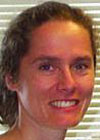 |
|
|
| Author |
Message |
Amy_Clapp

Joined: 23 Mar 2004
Posts: 84

|
 Posted:
Fri May 28, 2004 5:25 pm Posted:
Fri May 28, 2004 5:25 pm |
  |
May 28, 2004
Weather: Sunny
Sunrise: 1: 37 a.m.
Sunset: 11: 46 p.m.
# of daylight hours: 22 hours 9 minutes
High Temp: 12 °C 56°F—It was beautiful today!!!!
Low Temp: -1°C 30°F
Average Temp: 5.5.°C 43°F
Precipitation: No
Form:
How Much:
Today, the “real” science began. We took our first samples from the Lena!! Our day started by going to a couple of places in the village where some of the equipment from last year was stored. We were looking for an extension pole that had a hook on which you could attach a water bottle. We found the pole and the correct water bottle, but we wouldn’t find the attachment, so we improvised and it worked rather well.

The Lena was moving at about 1 meter (a little bit over 3 feet) per second. It was cool to see all these icebergs floating down and to think that in a few days the river will be flowing at 6-7 meters per second and there will be tons of icebergs. This will be exciting. However, we were all stumped by these ice balls on top of the ice—how do you think that they got there? We all have our guesses and want to know what you think!!!

The next ten days are the “big event” for this river for the year. The river will go from being at its lowest level to going to its highest level in the next 10 days. So, we will take water samples from the river each of these days to see how the chemicals in the water change during this period. Today we took samples to measure the oxygen and hydrogen isotopes in the water in the Lena River. Water is made up of two different elements, hydrogen and oxygen. There can be different types of hydrogen and different types of oxygen that weigh different amounts. These are called isotopes. Water from different sources like snow, groundwater, or rain, can have different isotopes of oxygen or/and hydrogen to make up the water. What we think is that there will be different isotopes of water during the next 10 days because the water is going to be coming from different sources. So, to take this sample, we collected water and poured it right into another bottle. This bottle will be sent back to the Marine Biological Lab in Woods Hole (where Max works) and then will be analyzed in a lab in Canada.

Our second sample was for nutrients. The nutrients that will be looking for in this sample are Nitrate and Phosphate. These are the nutrients that phytoplankton (tiny, tiny little plants—Salisbury 4,5,6 graders, you have pictures of these in your STUDENTS notebook) need to grow. When this sample is analyzed, Max will get a number of how many nitrate molecules or phosphate molecules are in a liter of water. Then Max can take that number and multiply it by the amount of water that is being discharged (amount of water flowing down the river) and then he will know how many of these nitrate and phosphate molecules are being dumped into the Arctic Ocean by the Lena River.
The third sample was for dissolved organic carbon. The tea you drink is dissolved organic material that has a lot of carbon. If you put a tea bag in a cup of water for a little amount of time it gets a little bit brown; if you put it in a cup for a long time it gets browner. That is the same with the water—dissolved organic carbon is what makes it brown. Most of the dissolved organic carbon comes from the soil, and it got in the soil mostly from dead plants and animals. The Lena has a high concentration of dissolved organic carbon. This sample will get analyzed at the Marine Biological Lab or Yale University.

The last sample was done by Chris and was for trace metals. Chris will have these samples analyzed and will look for metals in the water that he will be able to use to follow the Lena River water once it gets to the Arctic Ocean. It is kind of like if all of these rivers were different colors based on what types of metals and other chemical are in them, then you could look in the Arctic Ocean and see where all the red water went (if for example the Lena River water was red based on the chemicals found in it).

We will take samples like this for the next several days, until the ice breaks up on the river and we can sample from the boat. At that point, we will take many more kinds of samples for lots of different chemical analyses (and we’ll get to use a lot of fun stuff like our winch and depth-integrating sampler).
 |
|
|
    |
 |
|
|
|
View next topic
View previous topic
You cannot post new topics in this forum
You cannot reply to topics in this forum
You cannot edit your posts in this forum
You cannot delete your posts in this forum
You cannot vote in polls in this forum
You cannot attach files in this forum
You can download files in this forum
|
Powered by phpBB 2.0.11
© 2001, 2002 phpBB Group :: FI Theme ::
All times are GMT
| |
